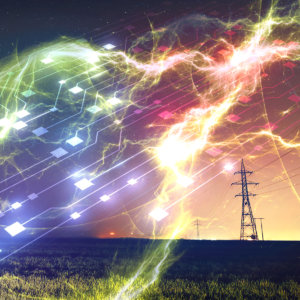Blockchain and the Clean, Smart Grid

Topics
Column
Blockchain is everywhere — at least when you’re talking about media coverage. It’s the new technology that enables those wild cryptocurrencies. But some techies think it will revolutionize more than money. In short, in the words of a recent Wired overview of the technology, blockchain creates “tamperproof databases.” Every transaction in some defined system, like all trades of a particular currency, is “cryptographically signed,” meaning it’s encoded to be theoretically unhackable. Then, the “block” of data, with its crypto info, is saved on thousands of computers in parallel — so that if you wanted to tamper with a record, you’d have to change everyone’s computer at the same time.
At first blush, it’s unclear why a really good, tamperproof database will be so groundbreaking. But big companies and startups alike are exploring how blockchain could change everything from contracts, corporate compliance, and auditing to digital identity and voting, supply chain tracking, and even building a smart, carbon-free electric grid. These ideas are fascinating, but the latter few in particular have caught my eye. Anything that might solve big, global, environmental, and social challenges, from climate change to reducing forced labor in the supply chain, is worth a look.
It’s impossible to unpack all of the potential ideas at once, so let’s talk about how blockchain might help with one critical aspect of the climate change fight: the challenges of managing clean, zero-carbon energy on the grid.
The pace of adoption of clean energy is breathtaking, but it’s not moving as fast as it could. One issue is that, as critics love to point out, the wind and sun are “intermittent” (they come and go). In parallel, how much energy we use swings wildly during the day. Demand in most regions peaks after dark, as everyone gets home from work, right when solar power is waning. This mismatch creates what the utilities call the “duck curve” problem, named for the misshapen curves of supply and demand. It’s a chaotic situation for utilities that are trying to keep a giant power grid in balance.
Massive battery storage will help solve the problem but getting to total grid scale is some ways off. We’ll also need demand-side options, such as a long-standing practice called “demand response.” When the utilities see fast-rising demand, they pay companies to reduce their energy demand by, for example, turning down their cooling systems a degree. Now imagine if billions of connected devices could adjust themselves to balance the grid. And then picture them talking directly to each other, partly through a shared, trusted system.
This is where blockchain may come in.
Get Updates on Transformative Leadership
Evidence-based resources that can help you lead your team more effectively, delivered to your inbox monthly.
Please enter a valid email address
Thank you for signing up
Blockchain Could Make Tracking Energy More Granular, Automated, and Trusted
To understand how this new tech could be a solution to thorny grid problems, I spoke to Jesse Morris from the Rocky Mountain Institute (RMI), based in Colorado. The nonprofit has cofounded, with the Austria-based startup Grid Singularity, the Energy Web Foundation (EWF), headquartered in Zug, Switzerland. The new organization is hoping to provide an open-source blockchain platform to the energy sector and accelerate the transition to renewables.
Imagine, Morris said, if every utility meter “assigned a crypto identity and time stamp, with geolocation,” to every unit of energy used and produced. On the supply side, the system would track every kilowatt hour of renewable energy generated. That would be useful to all those multinationals buying gigawatts of renewable power every year.
Right now, when utilities or companies buy renewables, they basically have three choices: Finance their own projects and own the panels or turbines, sign power purchase agreements (PPAs) to buy clean power from someone else for the next 15 to 20 years, or purchase certificates that represent the green attributes of energy. Some critics of these renewable energy certificates (RECs) question whether they truly drive new investment in clean energy — and thus whether the cleanly sourced electrons are actually displacing dirtier energy on the grid.
Morris believes that blockchain can help by making tracking more granular, automated, and trusted, which can allow companies to better verify claims of carbon neutrality. It will also help avoid double-counting on RECs or PPAs (that is, an energy developer and the buyer of RECs might count the clean energy as their own). So we’ll know how much progress on carbon reduction we’re really making.
Financing New Energy Projects Could Be Streamlined
Blockchain may also help increase the supply of renewable energy in another way. It could streamline the financing and insuring of new energy projects, which can get complicated and expensive. One new company I spoke with San Francisco-based, Banyan Infrastructure Corp., is piloting a blockchain ledger to manage the contractual obligations — of the developer, the buyer of the energy, the lender, and so on — and to lower some of these administrative costs. Since these costs are mostly fixed, smaller projects like a 10-megawatt solar farm would benefit the most.
But the real potential, according to Banyan’s CEO Tad Neeley, is to use blockchain ledgers to reduce the capital requirements for new projects.
The problem is this: Banks place conservative debt service requirements on the developers of renewables projects (because of uncertainties, some real and some exaggerated, about how dependable solar or wind farms are). The developers must keep a lot of cash on hand to ensure that they can meet loan payments. Neeley believes that a shared, real-time database that is tracking energy production can help lower the perceived risk and thus reduce these capital requirements. A shared ledger could make investors more comfortable that the turbines and panels will continue spinning off both electrons and cash.
Tamperproof Ledgers Could Facilitate a New Energy Market
So blockchain may help increase the supply of clean energy — but now consider the demand side. Millions of individual devices and building systems could track their needs and trade electricity device to device, across the full grid, or on small, localized microgrids. Blockchain’s shared, tamperproof ledger could verify all transactions, creating a new kind of energy market.
Of course, these visions of the near future create as many questions as they answer, such as: What’s the role of the utility when my refrigerator is talking to your HVAC system, or your solar panels are selling power to my electric car? This is not some completely futuristic scenario — the first blockchain-enabled sale of power from one neighbor to another just happened in England. And what, if anything, replaces the oversight and management of the shared resource that we call “the grid”?
But even with so much unanswered, bringing some excitement to this thorny problem of building a clean grid is a good thing in and of itself. It would be great to move beyond cryptocurrencies and bring blockchain innovation to cool, real-world problems like how every single thing that uses or produces electricity will communicate and optimize energy use. Or how to build a zero-carbon grid and tackle climate change.
This is all new territory, and I’m planning to dive into different parts of this story over time. The prospect of better tracking of supply chains, or of tracking carbon footprints for every product, is exciting. Stay tuned, as I’m sure there are newer blockchain applications — both real and hyped — to come.


Comment (1)
John Mathew